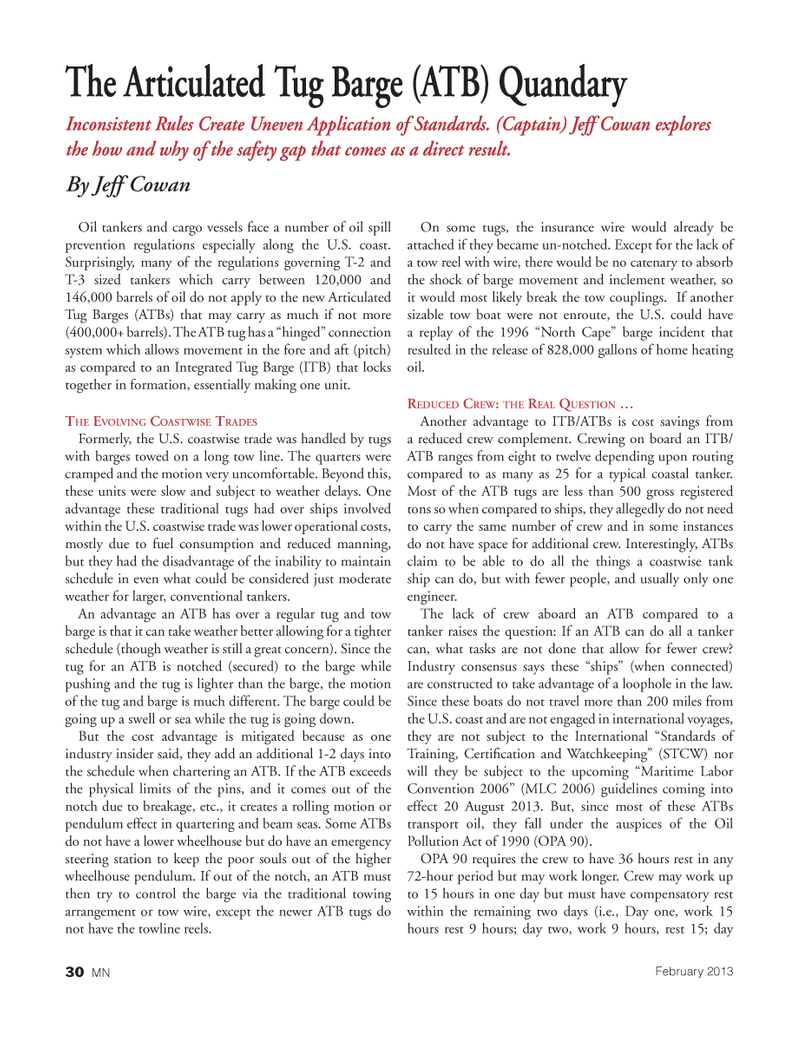
Page 30: of Marine News Magazine (February 2013)
Bulk Transport Leadership Roundtable
Read this page in Pdf, Flash or Html5 edition of February 2013 Marine News Magazine
Oil tankers and cargo vessels face a number of oil spill prevention regulations especially along the U.S. coast. Surprisingly, many of the regulations governing T-2 and T-3 sized tankers which carry between 120,000 and 146,000 barrels of oil do not apply to the new Articulated Tug Barges (ATBs) that may carry as much if not more (400,000+ barrels). The ATB tug has a ?hinged? connection system which allows movement in the fore and aft (pitch) as compared to an Integrated Tug Barge (ITB) that locks together in formation, essentially making one unit.THE EVOLVING COASTWISE TRADESFormerly, the U.S. coastwise trade was handled by tugs with barges towed on a long tow line. The quarters were cramped and the motion very uncomfortable. Beyond this, these units were slow and subject to weather delays. One advantage these traditional tugs had over ships involved within the U.S. coastwise trade was lower operational costs, mostly due to fuel consumption and reduced manning, but they had the disadvantage of the inability to maintain schedule in even what could be considered just moderate weather for larger, conventional tankers. An advantage an ATB has over a regular tug and tow barge is that it can take weather better allowing for a tighter schedule (though weather is still a great concern). Since the tug for an ATB is notched (secured) to the barge while pushing and the tug is lighter than the barge, the motion of the tug and barge is much different. The barge could be going up a swell or sea while the tug is going down. But the cost advantage is mitigated because as one industry insider said, they add an additional 1-2 days into the schedule when chartering an ATB. If the ATB exceeds the physical limits of the pins, and it comes out of the notch due to breakage, etc., it creates a rolling motion or pendulum effect in quartering and beam seas. Some ATBs do not have a lower wheelhouse but do have an emergency steering station to keep the poor souls out of the higher wheelhouse pendulum. If out of the notch, an ATB must then try to control the barge via the traditional towing arrangement or tow wire, except the newer ATB tugs do not have the towline reels. On some tugs, the insurance wire would already be attached if they became un-notched. Except for the lack of a tow reel with wire, there would be no catenary to absorb the shock of barge movement and inclement weather, so it would most likely break the tow couplings. If another sizable tow boat were not enroute, the U.S. could have a replay of the 1996 ?North Cape? barge incident that resulted in the release of 828,000 gallons of home heating oil.REDUCED CREW : THE REAL QUESTION ?Another advantage to ITB/ATBs is cost savings from a reduced crew complement. Crewing on board an ITB/ ATB ranges from eight to twelve depending upon routing compared to as many as 25 for a typical coastal tanker. Most of the ATB tugs are less than 500 gross registered tons so when compared to ships, they allegedly do not need to carry the same number of crew and in some instances do not have space for additional crew. Interestingly, ATBs claim to be able to do all the things a coastwise tank ship can do, but with fewer people, and usually only one engineer. The lack of crew aboard an ATB compared to a tanker raises the question: If an ATB can do all a tanker can, what tasks are not done that allow for fewer crew? Industry consensus says these ?ships? (when connected) are constructed to take advantage of a loophole in the law. Since these boats do not travel more than 200 miles from the U.S. coast and are not engaged in international voyages, they are not subject to the International ?Standards of Training, Certi cation and Watchkeeping? (STCW) nor will they be subject to the upcoming ?Maritime Labor Convention 2006? (MLC 2006) guidelines coming into effect 20 August 2013. But, since most of these ATBs transport oil, they fall under the auspices of the Oil Pollution Act of 1990 (OPA 90). OPA 90 requires the crew to have 36 hours rest in any 72-hour period but may work longer. Crew may work up to 15 hours in one day but must have compensatory rest within the remaining two days (i.e., Day one, work 15 hours rest 9 hours; day two, work 9 hours, rest 15; day The Articulated Tug Barge (ATB) Quandary The Articulated Tug Barge (ATB) Quandary Inconsistent Rules Create Uneven Application of Standards. (Captain) Jeff Cowan explores Inconsistent Rules Create Uneven Application of Standards. (Captain) Jeff Cowan explores the how and why of the safety gap that comes as a direct result. the how and why of the safety gap that comes as a direct result. By Jeff Cowan 30 MNFebruary 2013 MN Feb2013 Layout 18-31.indd 30MN Feb2013 Layout 18-31.indd 301/30/2013 4:50:05 PM1/30/2013 4:50:05 PM

 29
29

 31
31
